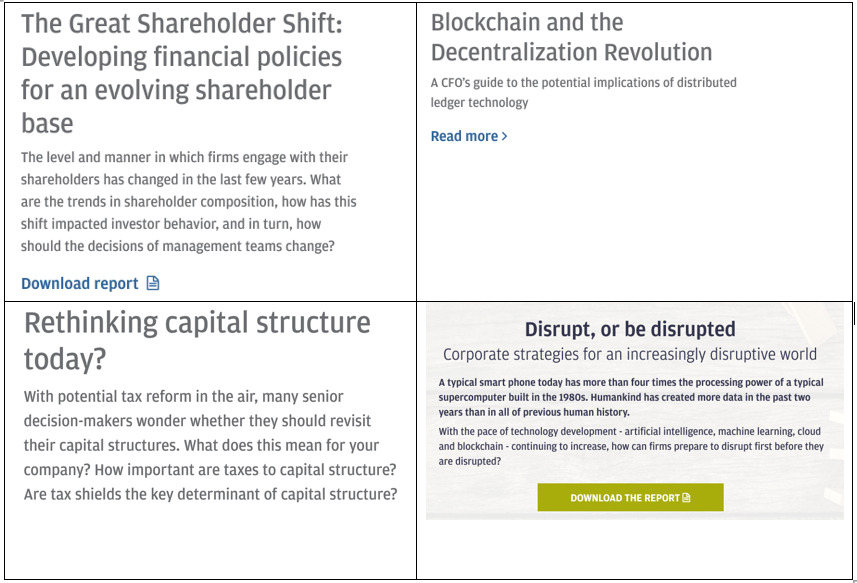Banking on Thought Leadership
J.P. Morgan’s Content: Avoiding Dead Ends in the User Journey
Each week we examine a different investment bank’s content and highlight three things we like about their approach to thought leadership. Our goal is to help investment banking marketers learn about the best practices in thought leadership and elevate their content.
Overview of J.P. Morgan’s Thought Leadership: J.P. Morgan is the top underwriter of global debt and equity volume on Wall Street, and one of the leading investment banks when it comes to global M&A deal volume, according to Vault. Thought leadership is extremely prominent across J.P. Morgan’s investment banking web properties. In fact, the main investment banking page is entirely case studies and market commentaries; it doesn’t have the typical navigation focused on industries and services that you see with most investment banks. J.P. Morgan also has a separate, dedicated section for corporate finance advisory reports.
Highlights of our analysis of J.P. Morgan’s thought leadership:
- Avoids dead ends in the user journey
- Dives deep into proxy season
- Focuses on user pain points
- One piece of unsolicited advice: Make landing pages easier to scan
Three Things We Like

1. Avoids dead ends in the user journey.
Too often investment banks will feature outstanding content that draws a prospect into the site. But once the user gets to the end of the article, there isn’t a suggested next step. J.P. Morgan does an excellent job of avoiding these “dead ends” throughout its thought-leadership content.
Every article ends with “Related Insights,” which are tiles of three articles or case studies that invite the user to continue exploring. For example, in June 2020, J.P. Morgan published a case study about its $3.5 billion financing for Delta to help the airline navigate the unprecedented challenges created by COVID-19. The end of that article includes tiles for case studies of three other financings that J.P. Morgan completed that have some historical significance.

2. Dives deep into Proxy Season.
Many investment banks publish reports on shareholder activism and proxy voting activity. Some prominent examples include Lazard’s Quarterly Review of Shareholder Activism and Credit Suisse’s Shareholder Activism: an evolving challenge. We think that J.P. Morgan’s annual report, Proxy Season, is one of the better examples of this type of content.
In particular, we like how it includes short (one or two paragraphs) summaries of specific actions taken by activist managers, such as Wellington Management and T. Rowe Price. There are also short summaries of the ESG priorities of several leading passive investors (Vanguard, State Street, and CalPERS), activist managers (ValueAct Spring Fund, JANA Impact Capital, Impactive Capital, and Irrational Capital), and a proxy advisor (Glass Lewis). These summaries do an excellent job of quickly turning abstract trends into tangible stories.

3. Focuses on user pain points.
Unfortunately, much of investment banking thought leadership is an exercise in showing how much insight the bank has into a particular market or sector. And often the reader’s needs or concerns become an afterthought. J.P. Morgan does an outstanding job of avoiding this trap by focusing on the target audience’s pain points for its corporate finance thought leadership.
J.P. Morgan orients its corporate finance advisory reports around the dilemmas that a company’s executive team and board are wrestling with. This orientation can be seen in headlines and blurbs for white papers such as:

One Piece of Unsolicited Advice:
Make Landing Pages Easier to Scan
The primary goal of a landing page for a white paper, e-book, or other long-form content is to allow the user to quickly understand why they should want to invest time to explore further, which often includes providing an email address as the price of entry. An effective way to do this is by making the page easy to scan, including using bullet points or graphics to highlight the key takeaways that the reader will get from the full report.
J.P. Morgan does this well in several places, including the landing page for the Disrupt, or Be Disrupted white paper. But the 2019 Proxy Season landing page is simply two paragraphs of text. The highlights of the full report are embedded in the landing page’s paragraphs, but the reader has to work to find them. A simple bulleted list would solve this.

Ready for Your Deep Dive?
Schedule your content audit. Want to know how your firm’s thought leadership and content marketing stack up against the industry’s best? Contact us to learn about engaging Wentworth Financial Communications to do an audit of your content’s strengths and areas for improvement.
Keep Exploring
See our thoughts on several companies we have recently analyzed or view the full archive.
Bank of America’s Content: Case Studies That Show Tangible Impact
Banking on Thought LeadershipEach week we examine a different investment bank’s content and highlight three things we like about their approach to thought leadership. Our goal is to help investment banking marketers learn about the best practices in thought leadership...
Stephens’ Content: Strong Point of View on a Potentially Divisive Topic
Banking on Thought Leadership Each week we examine a different investment bank’s content and highlight three things we like about their approach to thought leadership. Our goal is to help investment banking marketers learn about the best practices in thought...
RBC Capital Markets’ Content: COVID Insights that Cut Through the Noise
Banking on Thought LeadershipEach week we examine a different investment bank’s content and highlight three things we like about their approach to thought leadership. Our goal is to help investment banking marketers learn about the best practices in thought leadership...



